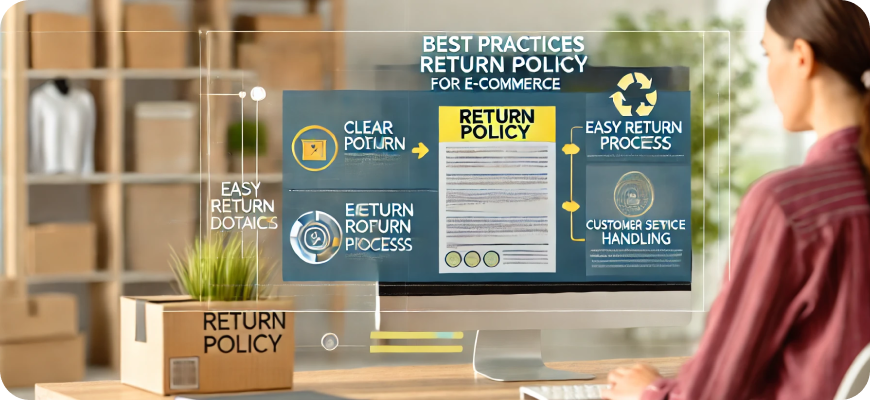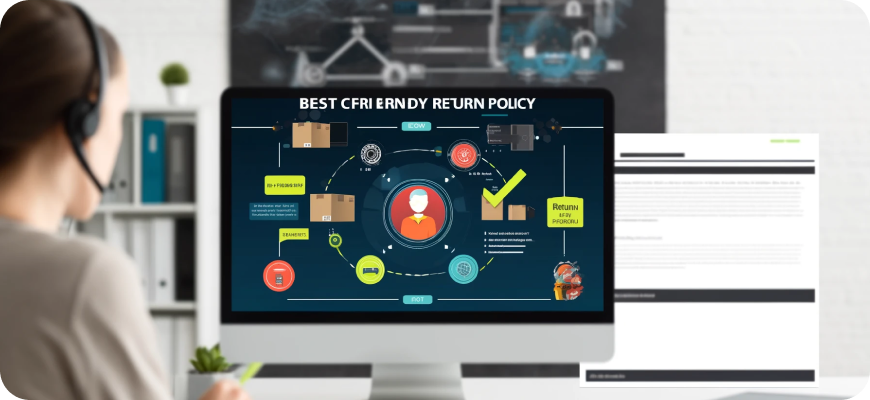Review your return policies with this guide
A well-crafted return policy is a cornerstone of a successful e-commerce business. It not only builds trust with customers but also directly impacts purchasing decisions and overall customer satisfaction. With the right approach, your return policy can drive repeat business, reduce support inquiries, and even turn potential returns into exchanges. However, designing an effective return policy requires careful consideration of several factors, including the types of products you sell, customer expectations, and logistical considerations. This guide will help you review and refine your return policy to optimize it for customer satisfaction and operational efficiency.

1. Understand the Importance of a Good Return Policy
A clear and customer-friendly return policy builds trust, encourages conversions, and strengthens brand loyalty. Research shows that over 60% of shoppers review the return policy before making a purchase, and a generous return policy can boost sales by providing a safety net for hesitant buyers.
Key Benefits of a Good Return Policy:
- Increased Conversion Rates: Customers are more likely to buy if they know they can return an item easily if it doesn’t meet their expectations.
- Improved Customer Loyalty: A seamless return experience encourages customers to return to your brand.
- Reduced Cart Abandonment: A well-communicated return policy can decrease the likelihood of cart abandonment by easing customer concerns.
2. Define Your Return Policy Goals
Before making changes, clarify the goals of your return policy. Ask yourself:
- Are you looking to reduce the volume of returns?
- Do you want to encourage exchanges over refunds?
- Are you aiming to improve the customer experience with faster processing?
By defining these goals, you can tailor your return policy to support both customer satisfaction and your business needs.
3. Identify Common Issues in Return Policies
Common pain points in return policies include restrictive time limits, unclear conditions, and complex processes. A good return policy should address these issues directly:
Common Issues:
- Short Return Windows: Offering only a limited period for returns (e.g., seven days) can deter customers.
- Restocking Fees: Charging restocking fees can be a turn-off, particularly for first-time buyers.
- Inconsistent Requirements: Having vague conditions about what qualifies for a return (e.g., unworn, unwashed) can lead to customer frustration.
- Complex Processes: Complicated processes for initiating returns and printing return labels add friction and deter customers from completing returns.
4. Simplify and Clarify Your Return Conditions
Your return policy should be straightforward and easily understood. Make sure customers are clear about what’s returnable, in what condition, and by when.
Key Elements to Clarify:
- Eligible Products: Clearly outline what items are eligible for return. For example, specify if certain items (like final sale or custom products) are non-returnable.
- Return Timeframe: Decide on a reasonable return window (e.g., 30-60 days) that balances customer needs with logistical considerations.
- Condition Requirements: Be specific about the condition in which returns are accepted (e.g., original packaging, tags attached, unused). Using visuals or examples can make these requirements clearer.
- Refund Options: Indicate whether customers will receive a refund to their original payment method, store credit, or an exchange. Offering options can be a good way to cater to customer preferences.
Example:
“Items can be returned within 30 days in their original condition with tags attached. We offer refunds to the original payment method, store credit, or exchange options.”
5. Make the Return Process Easy and Convenient
A simple return process increases customer satisfaction and improves the likelihood of repeat purchases. Here’s how to make returns easy:
Tips for an Easy Return Process:
- Provide a Prepaid Return Label: Offering a prepaid return label is convenient for customers and allows you to track returns.
- Enable Online Return Requests: Allow customers to initiate returns online by filling out a quick form on your website or logging into their account.
- Use QR Codes for Returns: Some retailers now offer QR codes for returns, which customers can use at designated drop-off locations, eliminating the need for a printed label.
- Automate Return Status Updates: Keep customers informed by sending automated emails with return status updates, such as when the return has been received and when the refund has been issued.
6. Consider Offering Free Returns
Free returns can improve customer satisfaction, though they may add to your operational costs. Offering free returns can be particularly beneficial for high-value items or items that are commonly returned due to sizing, such as clothing.
Pros of Free Returns:
- Increased Customer Trust: Customers feel more comfortable buying if they know they won’t be penalized for returning items.
- Higher Conversion Rates: Free returns encourage customers to make purchases they may otherwise be hesitant about.
- Competitive Advantage: Free returns set your brand apart, especially if competitors charge for returns.
Alternative to Free Returns:
If offering free returns across the board isn’t feasible, consider offering it selectively:
- For First-Time Purchasers: Let new customers experience a risk-free purchase to increase their trust in your brand.
- For Loyalty Program Members: Offer free returns as a loyalty benefit to reward and retain existing customers.
7. Implement a Flexible Exchange Policy
Encouraging exchanges over refunds can help maintain revenue while still providing a positive experience for customers. Make sure your policy is clear about how exchanges work and make it as convenient as possible.
Exchange-Friendly Tips:
- Offer Easy Size and Color Exchanges: For products like clothing, allow customers to easily swap sizes or colors if they’re not satisfied with the original choice.
- Provide Instant Store Credit for Exchanges: Some companies provide instant store credit for exchanges, which customers can use right away rather than waiting for their return to be processed.
- Set a Clear Process for Exchanges: Explain how to initiate an exchange, any differences in policy for exchanges versus returns, and any exclusions.
Example:
“We offer hassle-free exchanges. If your item doesn’t fit, you can easily swap it for another size or color. Just select your preference during the return process, and we’ll take care of the rest!”
8. Use Technology to Improve the Returns Process
Leverage technology to streamline your return process, making it easier for both customers and your internal team. Many return management software solutions simplify the return experience.
Return Management Solutions:
- Returnly: Provides a seamless return experience with instant credit options and customizable return portals.
- Loop Returns: Ideal for managing exchanges, allowing customers to swap items instead of opting for refunds.
- Narvar: Enhances the return process with automated tracking updates and branded return portals, keeping customers informed throughout the process.
- Happy Returns: Offers a range of return options, including QR code returns and drop-off locations for easy returns without requiring a box or label.
Benefits:
Using a return management system can reduce manual effort, automate updates for customers, and provide insights into return reasons and trends.
9. Be Proactive in Reducing Returns
While a strong return policy is important, minimizing returns can benefit both your business and customers. Here’s how to be proactive about reducing returns:
Tactics to Reduce Returns:
- Accurate Product Descriptions: Provide detailed descriptions, sizing guides, and images that accurately represent the product. If a product runs small or large, include this information to set customer expectations.
- Customer Reviews and Feedback: Display reviews that mention fit, color, or quality, which can guide other customers. Consider including a Q&A section where customers can ask questions about the product.
- Visual Sizing Guides: Especially for apparel, offer visual guides or virtual fitting tools that help customers choose the right size.
- Quality Control Checks: Ensure products are checked for quality and consistency to prevent returns due to defects or quality issues.
Benefits:
By proactively reducing returns, you not only save on operational costs but also enhance customer satisfaction by helping them make better purchase decisions.
10. Communicate Your Return Policy Clearly
The placement and clarity of your return policy are critical. Customers should be able to find your return policy easily and understand it without confusion.
Placement Suggestions:
- Product Pages: Include a brief statement about the return policy on each product page to ensure customers know it before they add items to their cart.
- Checkout Page: Provide a summary or link to the full return policy on the checkout page, which reassures customers before they finalize their purchase.
- Order Confirmation Emails: Include a summary of the return policy in the order confirmation email, along with a link to start a return if needed.
- Dedicated Returns Page: Have a dedicated page for returns that provides detailed information on return options, shipping information, and frequently asked questions.
11. Measure and Refine Your Return Policy Over Time
An effective return policy isn’t static. Use data and customer feedback to refine your return policy periodically to improve both customer satisfaction and business efficiency.
Metrics to Track:
- Return Rate: Monitor your return rate and identify patterns in returned products. High return rates may indicate issues with product quality or descriptions.
- Time to Process Returns: Track how long it takes to process returns and issue refunds. Reducing return processing time improves the customer experience.
- Customer Satisfaction: Collect feedback from customers regarding their return experience to identify areas for improvement.
- Return Reasons: Use return reason codes to identify why products are being returned. This data can help you make adjustments to product descriptions, sizing, or quality control processes.
Continuous Improvement:
Regularly review and update your return policy based on insights from these metrics. For example, if you notice a high return rate for a specific product, consider adjusting the product description or providing additional sizing guidance.

Conclusion
A well-designed return policy is essential for building customer trust, encouraging conversions, and fostering brand loyalty. By making your policy transparent, simple, and customer-friendly, you can turn returns from a potential pain point into an opportunity to strengthen customer relationships. Use this guide to review and optimize your return policy, ensuring it aligns with both your customers’ expectations and your business goals. A great return policy doesn’t just manage returns effectively; it can also enhance the overall customer experience, leading to increased loyalty and long-term success.






